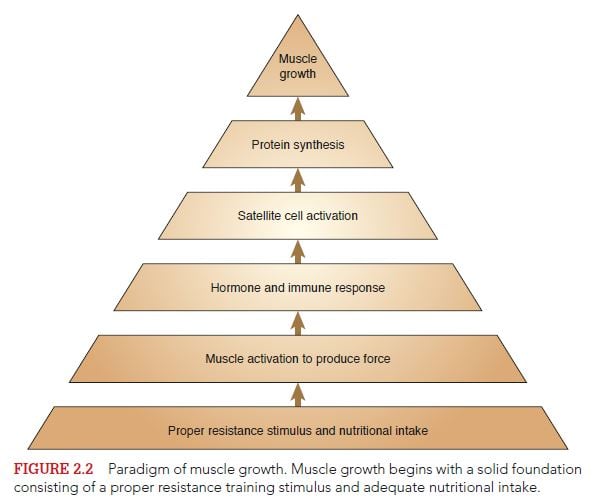Muscle Growth
by Strength Training
Kinetic Select
June 2020
This article briefly explains the two principles necessary for muscle growth.
The following is an exclusive excerpt from the book, Strength Training, Second Edition, published by Human Kinetics. All text and images provided by Human Kinetics.
In order for a muscle to get bigger it must increase in size. Historically, two primary mechanisms—hypertrophy and hyperplasia—have been proposed to explain how an increase in the size of an intact muscle might occur. Hypertrophy refers to an increase in the size of individual muscle fibers, whereas hyperplasia refers to an increase in the number of muscle fibers.
Research over the past 40 years has shown that the predominant mechanism for increasing muscle size is hypertrophy. Hyperplasia in humans may exist but is still very controversial as a major mechanism for increasing the intact size of a muscle (MacDougall et al. 1984; Alway et al. 1989; McCall et al. 1996). If hyperplasia does occur, it likely contributes very little (<5 percent) to absolute muscle growth, and anabolic drugs may play a role. Its existence may also be attributable to a mechanism called neural sprouting, where part of a muscle fiber without any neural connection that breaks away from the main fiber due to a clean breakage due to mechanical damage from exercise stress are attached to a neural sprout from another motor neuron and take on the characteristics of that motor unit, thereby increasing the number of fibers for that type of motor unit. However, we focus on skeletal muscle hypertrophy via an increase in muscle fiber size because this response has been demonstrated clearly in the research.
Two principles form the foundation of muscle growth. First, muscle must be stimulated to increase in size. However, that stimulus must be anabolic in nature. The anabolic stimulus appears to be related to the amount of resistance used in a lift and the associated neural activation in both men and women (Campos et al. 2002; Schuenke et al. 2013). Heavier resistance produces higher neural activation voltages in the recruitment of motor units. High voltage is needed for neural stimuli to activate high-threshold motor units; this high voltage also exposes lower-threshold motor units to the neural stimuli because recruitment always progresses from low- to high-threshold motor units. This was evidenced with biopsy training studies on the thigh muscle from Dr. Robert Staron’s research groups (Campos et al. 2002; Schuenke et al. 2013). These studies showed that when using only light weights (20-28RM), no hypertrophy of the Type I muscle fibers was seen. However, when using heavier resistance (9-11RM and 3-5RM), increases in cross-sectional area of all muscle fiber types were observed with training. In this context, the most prolific stimulus for muscle growth is a well-designed resistance exercise program of sufficient volume and sufficiently high intensity.
Second, increasing muscle size requires energy and the building blocks for new protein growth, both of which come from a properly designed and well-balanced diet that incorporates adequate calories and needed nutrients. As discussed in greater detail in chapter 4, nutrient intake is vital for optimal muscle development. The body needs carbohydrate, protein, and fat to repair and remodel muscle. Thus, everyday dietary patterns (including the timing of nutrient intake around the workout), appropriate sleep, and a healthy lifestyle all contribute to the effectiveness of muscle repair and, therefore, muscle growth.
If either of these principles is ignored, muscle simply will not adapt optimally for the desired hypertrophy. Figure 2.2 shows the basic paradigm of muscle growth and illustrates that the foundation for muscle growth consists of a proper resistance training stimulus and sound nutritional intake.

The popularity of endurance sports continues to grow worldwide. Now, from the National Strength and Conditioning Association (NSCA) comes the definitive resource for developing the endurance training programs that maximize performance and minimize injuries. The book is available in bookstores everywhere, as well as online at the NSCA Store.
- Privacy Policy
- Your Privacy Choices
- Terms of Use
- Retraction and Correction Policy
- © 2025 National Strength and Conditioning Association